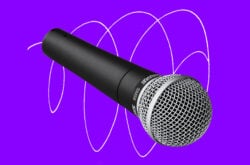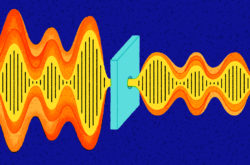There’s no shortage of headphones out on the market – so how do you know which pair will serve you best?
At the end of the day, what a good pair of headphones means for you is really going to depend on your specific needs and situation. Do you want to use them while you exercise, or while traveling? Will they be mostly for casual listening, or for music production? Let’s keep these scenarios in mind as we go through some of the most important features that distinguish headphones from each other to help you find the perfect pair.
1. On-ear, over-ear, and in-ear headphones
Possibly the most obvious characteristic of these listening devices is the way they fit on your ears and head. Here are the most common ones you’ll find today:
- In-ear headphones: These are your typical “earbuds” like the EarPods you get with an iPhone. Unlike the next two formats, these headphones are placed partially within each ear and can have really small drivers (a.k.a. speakers) as a result. Earbuds can be great for exercising or commuting because of their small form factor, and can even do a decent job of keeping out unwanted ambient noise.
- Over-ear headphones: These are designed to fit over the entire ear. This can be great for keeping sounds from both bleeding out and coming in, but it comes at a cost. They may not be as attractive for on-the-go or athletic types due to their larger size, but will almost always be the clear winner when it comes to music production or serious listening. Examples here include Audio Technica’s M-Series and Sony’s MDR series.
- On-ear headphones: These fit on top of each ear without covering them entirely. They represent a bit of both of the above worlds; they’re more portable and lighter than over-ears and usually have better overall sound quality than in-ear headphones due to larger drivers. Examples range from Grado’s SR series to pairs like the Sennheiser HD 25, which lend themselves especially well to DJing.
2. Open-back vs. closed-back headphones
Let’s say you’ve decided on over-ear headphones – but did you know that they come in two distinct flavors? With the open-back style, the earcups are intentionally designed to allow some sound to escape from the headphones. This creates a clearer and more spacious listening experience, which is great for mixing in a quiet setting, but not ideal for most other environments due the exposed design. Closed-back headphones do pretty much the opposite by creating a seal between the listener’s ears and the outside world – nothing comes in, and nothing goes out. This is great for recording live audio, since you’ll want the artist to hear the mix but make sure nothing except their performance makes it to the microphone. You can compare these two styles by checking out the DT-990 Pro (open-back) and DT 770 Pro (closed-back) from Beyerdynamic.
3. Wireless connectivity
When you get a spark of musical inspiration or see your favorite artist drop a new track, the last thing you want to do is sift through a mess of tangled cords. Wireless headphones are especially useful for those who commute or travel frequently, but can also be great at home since you can walk away from your TV or computer without losing audio. However, there are still some limitations worth considering before investing in a pair of these. Wireless transmission often means a dip in audio quality; the battery needs to stay charged, and the headphones can only be used with devices that can broadcast audio wirelessly (through something like Bluetooth, commonly along with a proprietary app). All that said, wireless headphones are becoming increasingly popular and can be found in pretty much any wear style.
4. Noise cancellation
Noise cancellation is great for any situation where you’d like to completely tune out the outside world, but shares some of the same potential drawbacks that accompany wireless connectivity. Bose’s QuietComfort series and Sony’s WH1000-MX3 are solid examples to check out if you want absolute control over your listening environment, no matter where that may be.
5. Frequency response
If you’re a music producer looking to use headphones in place of studio monitor speakers, you may want to take frequency response into consideration. This is a measure of how accurately the headphone’s speakers can evenly reproduce sound across a range of frequencies (usually 20 Hz – 20 kHz). Many headphones will boost the low-end and taper off the high-end to make up for how close the speakers are to your ears and create a more pleasant listening experience. While it’s next to impossible to create a truly flat curve, it’s good to be aware of how a pair of headphones will respond when playing different frequencies so you can compensate accordingly when mixing music.
6. Headphone impedance
Another measurement that often comes up when shopping for more professional-use headphones is impedance. Most consumer headphones come with a low impedance value like 32 ohms, which means they don’t need as much amplification power to make loud noises and work perfectly well with your computer or smartphone. Other models can go up to hundreds of ohms, and may require a professional-grade audio interface or powered amplifier to deliver the same levels. This may make them difficult to use outside of your home or studio, but will result in better bass definition, stereo image, and dynamics.
7. Comfort and cost
The final factors to consider can vary from person to person, but are often some of the most important to consider. Comfort can truly make or break a pair of headphones, because these are going to be sitting on your head and over your ears for hours at a time. If possible, read up on what others have experienced since some headphones may feel and fit differently after being broken in for a while. Cost is always going to be another major consideration when looking for a pair of headphones, and may often come down to whatever is currently in your budget. My recommendation here would be to think again about how you’ll be using them and for what. If you exercise every day or need to produce music from a thin-walled apartment, it may be worth it to do some serious research and invest in a higher-quality product that’s been proven to last.
Some other tips
Here are some final tips we’ll leave you with that may further inform your thinking around headphones:
- Most headphones are just fine for starting a track! Just remember that you may want to switch to something more suitable to the task like a pair of over-ears or a straight-up studio monitor setup when it comes time to mix everything down.
- I love testing out new tunes on any pair of headphones I can find. Just like with different types of speakers or environments, you’ll want to compare the levels of your music in multiple playback situations. Considering how many people prefer listening to music on headphones, the more the merrier!
- Whether it’s in-store, from a trial offer, or through a friend who already has a pair, try them before you make a purchase whenever possible!
Hopefully this article gave you some useful factors to consider when it comes to selecting the right headphones. If you have any questions, leave them in the comments below.
Explore royalty-free one-shots, loops, FX, MIDI, and presets from leading artists, producers, and sound designers:
April 16, 2020



